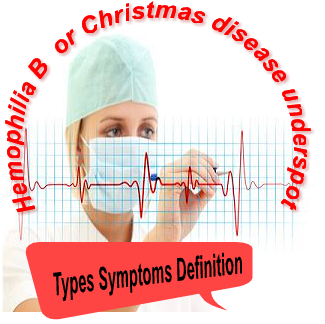Hemophilia B
Hemophilia B also known as factor IX deficiency or Christmas disease is a rare congenital bleeding disorder caused by factor IX deficiency and characterized by prolonged spontaneous bleeding and easy bruising.[1][10]
Hemophilia B is four times less common than hemophilia A, it occurs in one in 50,000 live male births.
- Hemophilia B is the second most common type of hemophilia.
The prevalence of hemophilia B is estimated to be 2.9 cases per 100,000 Americans. In 2013, 4000 Americans had hemophilia B, whereas the number of U.S. males with hemophilia is estimated to be about 20,000 individuals.[2][3][4]
Causes
Christmas disease or hemophilia B is an inherited disorder caused by factor IX deficiency, a protein necessary for blood to clot (coagulation factor); However, the majority of cases of hemophilia B occur spontaneously with no family history (less than 35%), most cases begin in late adolescence or early adulthood (between ages 16 and 30) as a result of a spontaneous gene mutation (de novo mutation of unknown cause).
Hemophilia B is a real challenge for patients suffering of it.
Treatment for hemophilia B depends largely on the severity of symptoms. And just like Hemophilia A, Christmas disease is a lifelong condition requiring complex self-care for the management of minor symptoms and general health, and ongoing medical support from doctors or medical professionals.
Severity of Hemophilia B
There are three levels of hemophilia B severity:
- Mild (5 to 50% of FIX in the blood).
- Moderate (1 to 5% of factor level in the blood).
- Severe (<1% of FIX in the blood).
Symptoms
Symptoms of hemophilia B depend on the severity of the condition. Prolonged spontaneous bleeding and easy bruising are the most common symptoms. People with mild hemophilia B may have few or no symptoms, some people may experience such symptoms as mild-to-moderate bleeding, etc. that usually follows a procedure, such as minor surgical operation, dental procedure, various accidents or general surgical treatments. In these cases, it is important to let your dentist and/or other healthcare professional(s) know about your condition before the procedure starts, so they can take the necessary precautions ahead of time.
Other symptoms of hemophilia B include:
Spontaneous Nosebleeds (epistaxis), nosebleeds with no obvious reason.[1][8][9]
Bleeding in the mouth, for example from biting a sharp object, or from losing a tooth
Heavy bleeding from a minor injury or cut
Rebleeding from a minor injury or cut after it stopped bleeding for a short period of time.[1][6][7]
Hematuria (red urine or urinary blood) or Hematochezia (blood in stool or blood in faeces) can be caused by a variety of conditions and diseases such as internal bleeding, infections, hemorrhoids, enlarged prostate, cancerous and noncancerous tumors, anal fissures, etc.
Arthralgia and swelling of joints, joints are tender and warm to touch
Spontaneous bleeding episodes, People with moderate hemophilia B tend to have Spontaneous bleeding episodes that occur without obvious cause, the frequency of bleeding episodes are related to the level of FIX clotting activity. In severe hemophilia B, spontaneous joint or deep muscle bleeding is characteristic.
A parent’s guide to Haemophilia B
How to determine the symptoms and signs of hemophilia B in your children, to know if your child has the condition.
Parents of newborn children with hemophilia B are unlikely to notice symptoms in their babies, because in most cases hemophilia B appears in a family that has no family history of it.
In 35% of newly identified cases, prolonged bleeding may be the first indication of a bleeding disorder, it occurs after minor surgical procedures of early childhood such as male circumcision. Male circumcision is the surgical removal of the prepuce (foreskin) from the head of the penis (glans). Otherwise, the signs and symptoms of hemophilia B usually do not appear until early adulthood (youngsters between the ages of 7 and 12), when injuries are more often.
Signs predicting Christmas disease in toddlers might include:
Prolonged nosebleeds with no obvious reason
Excessive bruising, unexplained bruises on chest, stomach, back and buttocks that often gets worse, and bruises (bluish or purple-colored skin patches) that may appear and quickly spread at the smallest poke.
Bleeding in the mouth, unusual lip or tongue bleeding due to accidentally biting them. As toddlers tend to put everything in their mouths and nearly all young children love chewing everything.
The most common types of internal bleeding in hemophilia
- Joint bleeds
- Muscle bleeds
Internal bleeds can be suspected if you notice a stuporous child, in which the child resists movement because of pain (catatonic stupor of the affected area).
Treatment
Treatment will depend on the severity, Small cuts and minor bruises are casual injuries in patients with hemophilia B, such minor injuries can be routinely treated with a basic first aid; However, if not treated properly, severe traumatic injuries can result in serious health problems, which could potentially lead to physical impairment and disability.
Treatment of severe bleeding episodes usually involve replacing the missing clotting factor IX (FIX replacement therapy).
Prophylaxis
There is no cure for hemophilia B. However, with proper self-care and righteous preventative care plan, people with hemophilia B can live long and active lives.[1][11]
#Hemophilia B
References
- emc.healthyorthodoxmedicine
- hemophilia.org/About-Us/Fast-Facts
- cdc.gov/ncbddd/hemophilia/facts.html
- encyclopedia.com/medicine/diseases-and-conditions/pathology/hemophilia
- ncbi.nlm.nih.gov/pubmed/9840909
- apps.who.int/classifications/icd11/frozen-2014-10-01/l-m/en#!/http%3A%2F%2Fid.who.int%2Ficd%2Fentity%2F1901375668
- ncbi.nlm.nih.gov/books/NBK1495/
- ncbi.nlm.nih.gov/pmc/articles/PMC3096213/
- cdc.gov/ncbddd/hemophilia/facts.html
- nhlbi.nih.gov/health/health-topics/topics/hemophilia/
- hemophilia.org/Researchers-Healthcare-Providers/Medical-and-Scientific-Advisory-Council-MASAC/MASAC-Recommendations/MASAC-Recommendation-Concerning-Prophylaxis
Verified by: Dr.Diab (July 27, 2017)
Citation: Dr.Diab. (July 27, 2017). Hemophilia B Causes Symptoms and Treatment. Medcoi Journal of Medicine, 20(2). urn:medcoi:article2701.















There are no comments yet
Or use one of these social networks